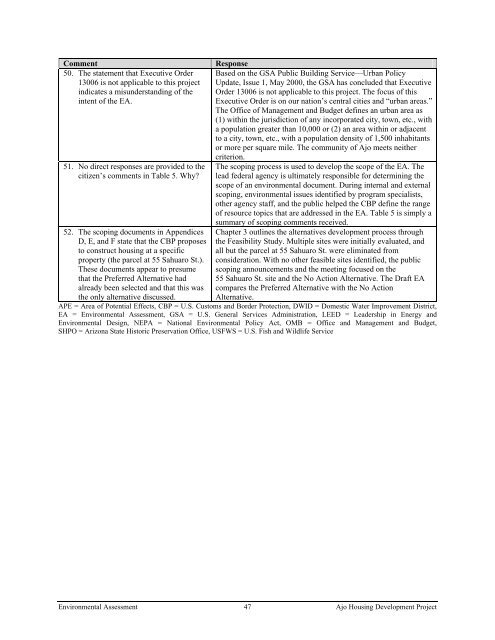US Customs and Border Protection Ajo Housing Development ... - GSA
US Customs and Border Protection Ajo Housing Development ... - GSA
US Customs and Border Protection Ajo Housing Development ... - GSA
You also want an ePaper? Increase the reach of your titles
YUMPU automatically turns print PDFs into web optimized ePapers that Google loves.
Comment<br />
50. The statement that Executive Order<br />
13006 is not applicable to this project<br />
indicates a misunderst<strong>and</strong>ing of the<br />
intent of the EA.<br />
51. No direct responses are provided to the<br />
citizen’s comments in Table 5. Why?<br />
52. The scoping documents in Appendices<br />
D, E, <strong>and</strong> F state that the CBP proposes<br />
to construct housing at a specific<br />
property (the parcel at 55 Sahuaro St.).<br />
These documents appear to presume<br />
that the Preferred Alternative had<br />
already been selected <strong>and</strong> that this was<br />
the only alternative discussed.<br />
Response<br />
Based on the <strong>GSA</strong> Public Building Service—Urban Policy<br />
Update, Issue 1, May 2000, the <strong>GSA</strong> has concluded that Executive<br />
Order 13006 is not applicable to this project. The focus of this<br />
Executive Order is on our nation’s central cities <strong>and</strong> “urban areas.”<br />
The Office of Management <strong>and</strong> Budget defines an urban area as<br />
(1) within the jurisdiction of any incorporated city, town, etc., with<br />
a population greater than 10,000 or (2) an area within or adjacent<br />
to a city, town, etc., with a population density of 1,500 inhabitants<br />
or more per square mile. The community of <strong>Ajo</strong> meets neither<br />
criterion.<br />
The scoping process is used to develop the scope of the EA. The<br />
lead federal agency is ultimately responsible for determining the<br />
scope of an environmental document. During internal <strong>and</strong> external<br />
scoping, environmental issues identified by program specialists,<br />
other agency staff, <strong>and</strong> the public helped the CBP define the range<br />
of resource topics that are addressed in the EA. Table 5 is simply a<br />
summary of scoping comments received.<br />
Chapter 3 outlines the alternatives development process through<br />
the Feasibility Study. Multiple sites were initially evaluated, <strong>and</strong><br />
all but the parcel at 55 Sahuaro St. were eliminated from<br />
consideration. With no other feasible sites identified, the public<br />
scoping announcements <strong>and</strong> the meeting focused on the<br />
55 Sahuaro St. site <strong>and</strong> the No Action Alternative. The Draft EA<br />
compares the Preferred Alternative with the No Action<br />
Alternative.<br />
APE = Area of Potential Effects, CBP = U.S. <strong>Customs</strong> <strong>and</strong> <strong>Border</strong> <strong>Protection</strong>, DWID = Domestic Water Improvement District,<br />
EA = Environmental Assessment, <strong>GSA</strong> = U.S. General Services Administration, LEED = Leadership in Energy <strong>and</strong><br />
Environmental Design, NEPA = National Environmental Policy Act, OMB = Office <strong>and</strong> Management <strong>and</strong> Budget,<br />
SHPO = Arizona State Historic Preservation Office, <strong>US</strong>FWS = U.S. Fish <strong>and</strong> Wildlife Service<br />
Environmental Assessment 47 <strong>Ajo</strong> <strong>Housing</strong> <strong>Development</strong> Project
















